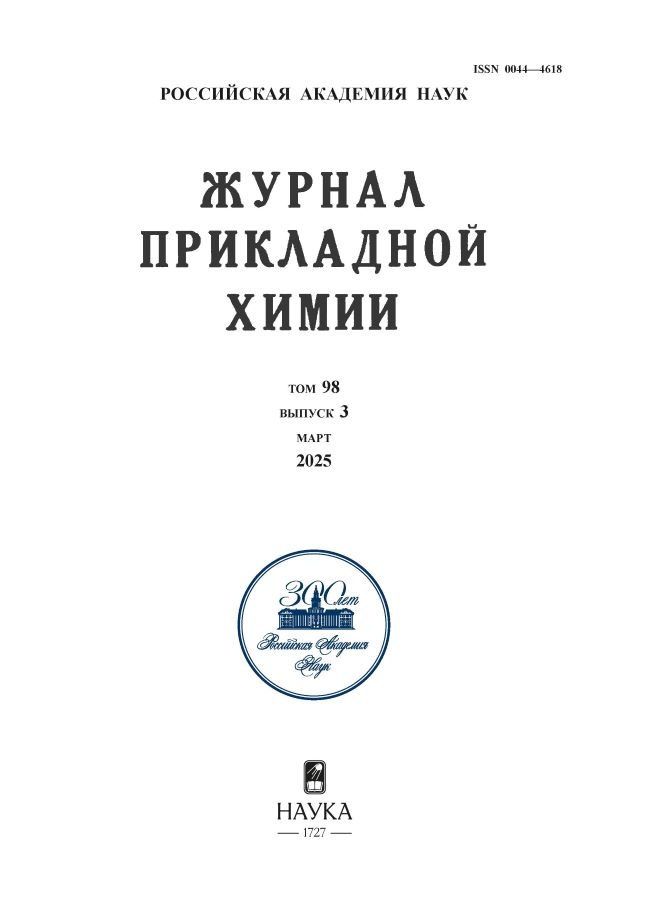Влияние природы и концентрации горючего агента на структуру и морфологию микросфер ZnO, полученных методом горения реакционных аэрозолей
- Авторы: Ермекова Ж.С.1, Росляков С.И.1, Юрлов С.С.1, Биндюг Д.В.1, Чернышова Е.В.1, Савилов С.В2,3
-
Учреждения:
- Национальный исследовательский технологический университет МИСИС
- Московский государственный университет им. М. В. Ломоносова
- Институт нефтехимического синтеза им. А. В. Топчиева РАН (ИНХС РАН)
- Выпуск: Том 96, № 4 (2023)
- Страницы: 330-336
- Раздел: Статьи
- URL: https://innoscience.ru/0044-4618/article/view/668143
- DOI: https://doi.org/10.31857/S0044461823040011
- EDN: https://elibrary.ru/OEVYWW
- ID: 668143
Цитировать
Полный текст
Аннотация
Ультрадисперсные сферические порошки ZnO c термоэлектрическими свойствами получены методом горения реакционных аэрозолей с добавлением 4 видов топлив: уротропина, глицина, мочевины, лимонной кислоты. С применением рентгенофазового анализа, сканирующей электронной микроскопии и низкотемпературной адсорбции азота продемонстрировано влияние основных параметров процесса (состав и концентрация топлива, температура и скорость несущего газа) на структуру и морфологию частиц ZnO. Установлено, что температуры синтеза 700°C достаточно для получения кристаллического ZnO с гомогенным фазовым составом независимо от вида и количества топлива. Показано, что исходный рН раствора прекурсора не влияет на образование фазы ZnO. При скорости потока газа-носителя выше 4 л·мин-1 детектируются побочные продукты. Определено, что избыток и вид топлива существенно влияет на морфологию синтезированных микросфер ZnO, что может быть использовано для регулирования технологических характеристик порошка и кинетики его спекания.
Ключевые слова
Об авторах
Ж. С. Ермекова
Национальный исследовательский технологический университет МИСИС
Email: acjournal.nauka.nw@yandex.ru
119049, Moscow, Russia
С. И. Росляков
Национальный исследовательский технологический университет МИСИС
Email: acjournal.nauka.nw@yandex.ru
119049, Moscow, Russia
С. С. Юрлов
Национальный исследовательский технологический университет МИСИС
Email: acjournal.nauka.nw@yandex.ru
119049, Moscow, Russia
Д. В. Биндюг
Национальный исследовательский технологический университет МИСИС
Email: acjournal.nauka.nw@yandex.ru
119049, Moscow, Russia
Е. В. Чернышова
Национальный исследовательский технологический университет МИСИС
Email: acjournal.nauka.nw@yandex.ru
119049, Moscow, Russia
С. В Савилов
Московский государственный университет им. М. В. Ломоносова;Институт нефтехимического синтеза им. А. В. Топчиева РАН (ИНХС РАН)
Автор, ответственный за переписку.
Email: acjournal.nauka.nw@yandex.ru
119991, Moscow, Russia; 119991, Moscow, Russia
Список литературы
- Klingshirn C. ZnO: Material, physics and applications // ChemPhysChem. 2007. V. 8. N 6. P. 782-803. https://doi.org/10.1002/cphc.200700002
- Ren G., Lan J., Zeng C., Liu Y., Zha B., Butt S., Nan C. W. High performance oxides-based thermoelectric materials // JOM. 2015. V. 67. P. 211-221. https://doi.org/10.1007/s11837-014-1218-2
- Bugalia A., Gupta V., Thakur N. Strategies to enhance the performance of thermoelectric materials: A review //j. Renew. Sustain. Energy. 2023. V. 15. ID 032704. https://doi.org/10.1063/5.0147000
- Prasad R., Bhame S. D. Review on texturization effects in thermoelectric oxides // Mater. Renew. Sustain. Energy. 2020. V. 9. P. 1-22. https://doi.org/10.1007/s40243-019-0163-y
- Kolodziejczak-Radzimska A., Jesionowski T. Zinc oxide-from synthesis to application: A review // Materials. 2014. V. 7. P. 2833-2881. https://doi.org/10.3390/ma7042833
- Prabhuraj T., Prabhu S., Dhandapani E., Duraisamy N., Ramesh R., Kumar K. R., Maadeswaran P. Bifunctional ZnO sphere/r-GO composites for supercapacitor and photocatalytic activity of organic dye degradation // Diamond Relat. Mater. 2021. V. 120. ID 108592. https://doi.org/10.1016/j.diamond.2021.108592
- Xing Y., Zhang L. X., Chong M. X., Yin Y. Y., Li C. T., Bie L. J. In-situ construction of carbon-doped ZnO hollow spheres for highly efficient dimethylamine detection // Sens. Actuators. B. 2022. V. 369. ID 132356. https://doi.org/10.2139/ssrn.4009448
- Lee Y., Fujimoto T., Yamanaka S. Characterization of submicro-sized Ag/ZnO particles generated using the spray pyrolysis method // Adv. Powder Technol. 2022. V. 33. ID 103525. https://doi.org/10.1016/j.apt.2022.103525.
- Trusov G. V., Tarasov A. B., Goodilin E. A., Rogachev A. S., Roslyakov S. I., Rouvimov S., Mukasyan A. S. Spray solution combustion synthesis of metallic hollow microspheres //j. Phys. Chem. C. 2016. V. 120. N 13. P. 7165-7171. https://doi.org/10.1021/acs.jpcc.6b00788
- Yermekova Z., Trusov G., Roslyakov S. I. Spray solution combustion synthesis of NiCu hollow spheres // Int. Conf. on Mechanical, System and Control Engineer. Singapore: Springer Singapore, 2021. P. 11-17. https://doi.org/10.1007/978-981-16-9632-9_2
- Konstantinova E. A., Minnekhanov A. A., Trusov G. V., Kytin V. G. Titania-based nanoheterostructured microspheres for prolonged visible-light-driven photocatalysis // Nanotech. 2020. V. 31. ID 32392554. https://doi.org/10.1088/1361-6528/ab91f1
- Varma A., Mukasyan A. S., Rogachev A. S., Manukyan K. V. Solution combustion synthesis of nanoscale materials // Chem. Rev. 2016. V. 116. N 23. P. 14493-14586. https://doi.org/10.1021/acs.chemrev.6b00279
- Roslyakov S., Yermekova Z., Trusov G., Khort A., Evdokimenko N., Bindiug D., Mukasyan A. One-step solution combustion synthesis of nanostructured transition metal antiperovskite nitride and alloy // Nano-Struct. Nano-Objects. 2021. V. 28. ID 100796. https://doi.org/10.1016/j.nanoso.2021.10079
- Trusov G. V., Tarasov A. B., Moskovskikh D. O., Rogachev A. S., Mukasyan A. S. High porous cellular materials by spray solution combustion synthesis and spark plasma sintering //j. Alloys Compd. 2019. V. 779. P. 557-565. https://doi.org/10.1016/j.jallcom.2018.11.250
- Nesakumar N., Rayappan J. B. B., Jeyaprakas B. G., Krishnan U. M. Influence of pH on structural morphology of ZnO nanoparticle // Asian J. Appl. Sci. 2012. V. 12. N 16. P. 1758-1761. https://doi.org/10.3923/jas.2012.1758.1761
Дополнительные файлы











